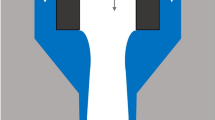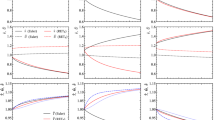Abstract
An extension of the recent work [15] has been made to evaluate the air core diameter both theoretically and experimentally in the case of a swirl nozzle using a time independent pure viscous power law non-Newtonian fluid. The theoretical predictions have been made through an approximated analytical solution of the hydrodynamics of flow inside the nozzle. A series of experiments has been carried out with solutions of CMC (carboxymethyl cellulose sodium salt) powder in water with different concentrations as the working fluids. The rheological properties of the working fluids were measured by a capillary tube viscometer. Finally it has been recognised from both the theory and experiment that, regarding the injection condition and the fluid properties, the generalised Reynolds number \(\operatorname{Re} _{G_i } \) at the inlet to the nozzle and the flow behaviour index n of the fluid become the pertinent independent input parameters in non-dimensional forms. The air core diameter increased with \(\operatorname{Re} _{G_i } \) and decreases with n. The effect of nozzle geometry on the air core diameter is similar to that in the case of Newtonian fluids [15].
Similar content being viewed by others
Abbreviations
- A E :
-
Area of tangential inlet ports of the nozzle
- A 2 :
-
Area of the orifice
- a :
-
Air core radius
- D 1 :
-
Swirl chamber diameter
- D 2 :
-
Orifice diameter
- D a :
-
Air core diameter
- E :
-
A nondimensional parameter defined by the equation (2.11)
- E R :
-
A nondimensional parameter defined by the equation (2.31)
- K :
-
Flow consistency index
- L 1 :
-
Length of the swirl chamber
- n :
-
Flow behaviour index
- P :
-
Static pressure
- P b :
-
Back pressure of the nozzle
- Q :
-
Volume flow rate
- R :
-
Radius vector or the longitudinal co-ordinate with respect to spherical co-ordinate system (Fig. 2.3)
- R 1 :
-
Radius of the swirl chamber
- R 2 :
-
Radius of the orifice
- \(\operatorname{Re} _{G_i } \) :
-
Generalised Reynolds number at inlet to the nozzle
- R z :
-
Radius of the nozzle at any section
- r :
-
Radial distance from the nozzle axis
- U :
-
Longitudinal component of velocity with respect to spherical co-ordinate system (Figure 2.3)
- V :
-
Component of velocity in the axial plane perpendicular to R as defined in (Figure 2.3)
- V r :
-
Radial velocity component
- V z :
-
Axial velocity component
- V φ :
-
Tangential velocity component
- \(\bar V_{\phi _i } \) :
-
Average tangential velocity at inlet to the nozzle
- W :
-
Component of velocity perpendicular to axial plane with respect to the spherical co-oridinate as defined in Figure 2.3
- z :
-
Distance along the nozzle axis from its inlet plane
- α :
-
Half of the spin chamber angle
- δ :
-
Boundary layer thickness
- δ 2 :
-
Boundary layer thickness at the orifice
- θ :
-
Angle which a radius vector according to the system of spherical coordinates (Figure 2.3) makes with the nozzle axis
- μ :
-
Dynamic viscosity
- ν :
-
Kinematic viscosity
- ρ :
-
Density
- φ :
-
Running co-ordinate in the aximuthal direction with respect to the cylindrical polar co-ordinate system as shown in Figure 2.3
- Ω:
-
Circulation constant
References
Taylor GI (1948) The Mechanics of Swirl atomizers. Proc. 7th Int. Cong. for Applied Mechanics Vol. 2, part 1, p 280
Novikov I (1949) Atomization of liquids by centrifugal nozzles. Engineers' Digest 10, 72
Taylor GI (1950) The boundary layer in the converging nozzle of a swirl atomizer. Qurt J Mech and Appl Math 3, 129
Binnie AM and Harris DP (1950) The application of boundary layer theory to swirling flow through a nozzle, Quart J Mech and appl Math 3, 89
Tate RW and Marshall WR (1953) Atomization by centrifugal nozzles, J Chem Engg Prog 49, 169–174
Nuttal JB (1953) Axial flow in a vortex. Nature 172, 532
Kelsal DF (1953) A further study of the hydraulic cyclone. Chem Eng Sci 2, 254
Talbot L (1954) Laminar Swirling pipe flow. J Appl Mech 21, 1
Binnie AM (1955) Viscosity effects in the nozzle of a swirl atomizer. Quar J Mech and Appl Math 8, 394
Binnie AM, Hakings GA and Kamel MYM (1957) The flow of swirling water through a convergent divergent nozzle, J Fluid Mech 3, 261
Binnie AM (1957) Experiments on the swirling flow of a viscous liquid through a tube. Quar J Mech and Appl Math 10, 276
Binnie AM and Tear JD (1965) Experiments on the flow of a swirling water through a pressure nozzle and on open trumpet. Proc Roy Soc Lond 235A, 78
Nizzam AH and Breason VP (1961) Swirling flow in cylinders, AIChEJ 7, 543
Som SK and Mukherjee SG (1980) ‘Theoretical and Experimental investigations on the coefficient of discharge and spray cone angle of a swirl spray atomizing nozzle’. Acta Mechanica 36, 79–102
Som SK and Mukherjee SG (1980) ‘Theoretical and Experimental investigations on the formation of air core in a swirl spray atomizing nozzle. App Sci Re 36, 173–196
Kreiger IM and Maron SHJ (1954) Direct determination of flow curves of non-Newtonian fluids. J Appl Phys 25, 72
Acrivos A, Shah MJ and Peterson EE (1960) Flow of a power law fluid on a rotating disk. J Appl Phys 31, 963–968
Bird R Byron, Stewart Warren E and Lightfoot Edwin N, Tangential annular flow of a non-Newtonian fluid between rotating cylinder. Transport Phenomena, John Wiley & Sons Inc, Copyright 1960
Skelland AHP, Laminar and turbulent boundary layer flows of power law fluids over a flat plate. Non-Newtonian flow and Heat transfer, John Wiley & Sons, Inc. 276–293, Copyright 1967
Author information
Authors and Affiliations
Rights and permissions
About this article
Cite this article
Som, S.K. Theoretical and experimental studies on the formation of an air core in a swirl spray pressure nozzle using a power law non-Newtonian liquid. Appl. Sci. Res. 40, 71–91 (1983). https://doi.org/10.1007/BF00539376
Issue Date:
DOI: https://doi.org/10.1007/BF00539376




